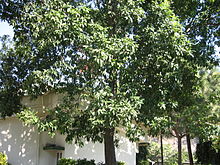Elaeocarpus ganitrus
| Elaeocarpus ganitrus | |
|---|---|
 |
|
| Scientific classification | |
| Kingdom: | Plantae |
| (unranked): | Angiosperms |
| (unranked): | Eudicots |
| (unranked): | Rosids |
| Order: | Oxalidales |
| Family: | Elaeocarpaceae |
| Genus: | Elaeocarpus |
| Species: | E. ganitrus |
| Binomial name | |
|
Elaeocarpus ganitrus Roxb. ex G.Don |
|
Elaeocarpus ganitrus, is a large evergreen broad-leaved tree whose seed is traditionally used for prayer beads in Hinduism and Buddhism. The seeds are known as rudraksha, or rudraksh, Sanskrit: rudrākṣa ("Rudra's Tear Drops"). Rudraksha may be produced by several species of Elaeocarpus; however, E. ganitrus is the principal species used in the making of organic jewellery or mala.
Rudraksha is a Sanskrit compound consisting of the name Rudra ("Shiva") and akṣha ("Tear Drops"). The specific epithet ganitrus is derived from ganitri, the name for this species in Sundanese and Malay.
Elaeocarpus ganitrus grows in the area from the Gangetic plain in the foothills of the Himalayas to South-East Asia, Nepal, Indonesia, New Guinea to Australia, Guam, and Hawaii. Rudraksha seeds are covered by an outer husk of blue colour when fully ripe, and for this reason are also known as blueberry beads. The blue colour is not derived from pigment but is structural. It is an evergreen tree that grows quickly. The rudraksha tree starts bearing fruit in three to four years. As the tree matures, the roots buttress rising up narrowly near the trunk and radiating out along the surface of the ground.
Chemical constituents present in E. ganitrus are elaeocarpidine, isoelaeocarpine, epiisoelaeocarpiline, rudrakine, flavonoids, quercetin, phytosterols, fat, alkaloids, carbohydrates, ethanol, proteins, tannins, gallic acid and ellagic acid.
...
Wikipedia
